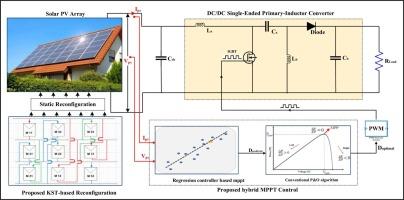Data-driven regression controller-based MPPT with image encryption inspired solar PV array reconfiguration under partial shading conditions
引用次数: 0
Abstract
Partial shading and environmental variations significantly reduce the power output and efficiency of photovoltaic (PV) systems, posing challenges for conventional maximum power point tracking (MPPT) methods that suffer from slow convergence, local maxima trapping, and high computational cost. To address these limitations, this paper proposes an image encryption-inspired PV array static reconfiguration technique based on the Kolakoski sequence transform (KST), combined with data-driven regression-based MPPT controllers. The proposed KST method minimizes current mismatches by intelligently redistributing shaded modules, while decision tree (DT), support vector machine (SVM), neural network (NN), and machine learning (ML) regression methods are employed to determine the optimal duty cycle for a SEPIC converter under varying irradiance conditions. The system is evaluated on both symmetrical 5 × 5 arrays and unsymmetrical 4 × 6 arrays, including experimental validation using a 250 Wp standalone PV setup. In MPPT performance, the regression-based controllers attain GMP enhancements of 47.09%, 45.14%, 27.27%, 13.62%, and 10.73% for 5 × 5 arrays and 74.96%, 44.11%, 40.14%, 18.29%, and 7.15% for 4 × 6 arrays under diverse environmental conditions. The reconfiguration technique achieves global maximum power (GMP) improvements of 32.79%, 14.98%, and 10.15% across various shading scenarios using 9 × 9 arrays. Notably, the proposed KST integrated with SVM regression-based MPPT delivers up to 68% GMPP enhancement, with >98.5% efficiency, convergence <0.35 s, and ripple ≤1.5%, validated across dynamic shading, temperature variation, rapid irradiance changes, and hotspot conditions. These results confirm the robustness, adaptability, and real-time suitability of the proposed KST integrated with ML-based Regression MPPT approach for practical PV optimization.

部分遮阳条件下基于数据驱动回归控制器的MPPT图像加密启发太阳能光伏阵列重构
部分遮阳和环境变化显著降低了光伏(PV)系统的输出功率和效率,对传统的最大功率点跟踪(MPPT)方法提出了挑战,这些方法存在收敛速度慢、局部最大值捕获和计算成本高的问题。为了解决这些限制,本文提出了一种基于Kolakoski序列变换(KST)的基于图像加密的光伏阵列静态重构技术,并结合基于数据驱动回归的MPPT控制器。提出的KST方法通过智能地重新分配阴影模块来最小化当前的不匹配,而决策树(DT)、支持向量机(SVM)、神经网络(NN)和机器学习(ML)回归方法用于确定不同辐照条件下SEPIC转换器的最佳占空比。系统在对称5 × 5阵列和非对称4 × 6阵列上进行了评估,包括使用250 Wp独立PV装置进行实验验证。在MPPT性能方面,基于回归的控制器在不同环境条件下对5个 × 5阵列的GMP增强率分别为47.09%、45.14%、27.27%、13.62%和10.73%,对4个 × 6阵列的GMP增强率分别为74.96%、44.11%、40.14%、18.29%和7.15%。重新配置技术在使用9 × 9阵列的各种遮光场景下实现了32.79%,14.98%和10.15%的全局最大功率(GMP)改进。值得注意的是,所提出的KST与基于SVM回归的MPPT相结合,提供了高达68%的GMPP增强,效率>;98.5%,收敛<;0.35 s,纹波≤1.5%,在动态遮阳,温度变化,快速光照变化和热点条件下都得到了验证。这些结果证实了所提出的KST与基于ml的回归MPPT方法集成在实际PV优化中的鲁棒性、适应性和实时性。
本文章由计算机程序翻译,如有差异,请以英文原文为准。
求助全文
约1分钟内获得全文
求助全文

 求助内容:
求助内容: 应助结果提醒方式:
应助结果提醒方式:


